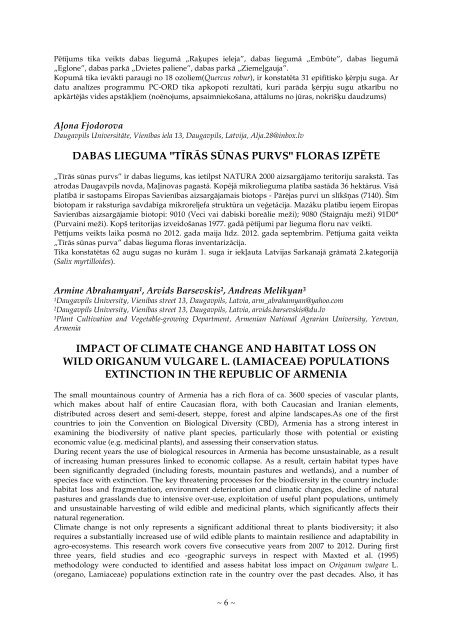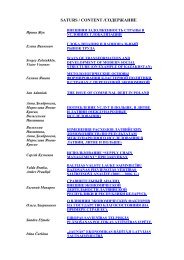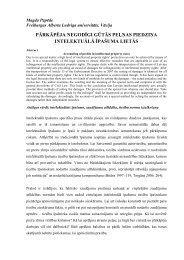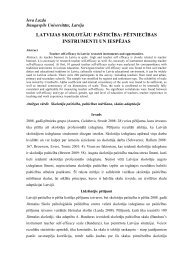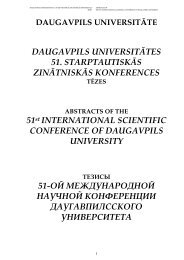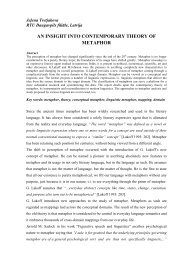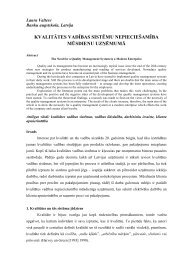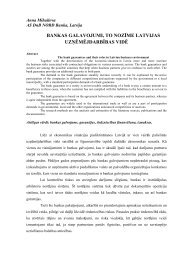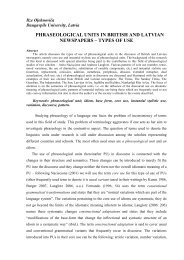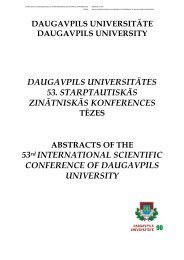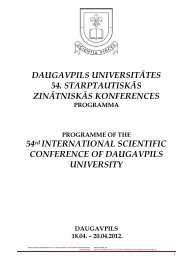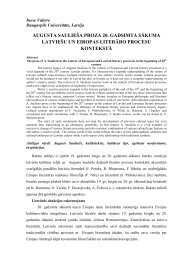Pētījums tika veikts dabas liegumā „Raėupes ieleja”, dabas liegumā „Embūte”, dabas liegumā„Eglone”, dabas parkā „Dvietes paliene”, dabas parkā „ZiemeĜgauja”.Kopumā tika ievākti paraugi no 18 ozoliem(Quercus robur), ir konstatēta 31 epifītisko ėērpju suga. Ardatu analīzes programmu PC-ORD tika apkopoti rezultāti, kuri parāda ėērpju sugu atkarību noapkārtējās vides apstākĜiem (noēnojums, apsaimniekošana, attālums no jūras, nokrišėu daudzums)AĜona Fjodorova<strong>Daugavpils</strong> Universitāte, Vienības iela 13, <strong>Daugavpils</strong>, Latvija, Alja.28@inbox.lvDABAS LIEGUMA "TĪRĀS SŪNAS PURVS" FLORAS IZPĒTE„Tīrās sūnas purvs” ir dabas liegums, kas ietilpst NATURA 2000 aizsargājamo teritoriju sarakstā. Tasatrodas <strong>Daugavpils</strong> novda, MaĜinovas pagastā. Kopējā mikrolieguma platība sastāda 36 hektārus. Visāplatībā ir sastopams Eiropas Savienības aizsargājamais biotops - Pārējas purvi un slīkšĦas (7140). Šīmbiotopam ir raksturīga savdabīga mikroreljefa struktūra un veăetācija. Mazāku platību ieĦem EiropasSavienības aizsargājamie biotopi: 9010 (Veci vai dabiski boreālie meži); 9080 (Staignāju meži) 91D0*(Purvaini meži). Kopš teritorijas izveidošanas 1977. gadā pētījumi par lieguma floru nav veikti.Pētījums veikts laika posmā no 2012. gada maija līdz. 2012. gada septembrim. Pētījuma gaitā veikta„Tīrās sūnas purva” dabas lieguma floras inventarizācija.Tika konstatētas 62 augu sugas no kurām 1. suga ir iekĜauta Latvijas Sarkanajā grāmatā 2.kategorijā(Salix myrtilloides).Armine Abrahamyan 1 , Arvids Barsevskis 2 , Andreas Melikyan 31 <strong>Daugavpils</strong> University, Vienibas street 13, <strong>Daugavpils</strong>, Latvia, arm_abrahamyan@yahoo.com2 <strong>Daugavpils</strong> University, Vienibas street 13, <strong>Daugavpils</strong>, Latvia, arvids.barsevskis@du.lv3 Plant Cultivation and Vegetable-growing Department, Armenian National Agrarian University, Yerevan,ArmeniaIMPACT OF CLIMATE CHANGE AND HABITAT LOSS ONWILD ORIGANUM VULGARE L. (LAMIACEAE) POPULATIONSEXTINCTION IN THE REPUBLIC OF ARMENIAThe small mountainous country of Armenia has a rich flora of ca. 3600 species of vascular plants,which makes about half of entire Caucasian flora, with both Caucasian and Iranian elements,distributed across desert and semi-desert, steppe, forest and alpine landscapes.As one of the firstcountries to join the Convention on Biological Diversity (CBD), Armenia has a strong interest inexamining the biodiversity of native plant species, particularly those with potential or existingeconomic value (e.g. medicinal plants), and assessing their conservation status.During recent years the use of biological resources in Armenia has become unsustainable, as a resultof increasing human pressures linked to economic collapse. As a result, certain habitat types havebeen significantly degraded (including forests, mountain pastures and wetlands), and a number ofspecies face with extinction. The key threatening processes for the biodiversity in the country include:habitat loss and fragmentation, environment deterioration and climatic changes, decline of naturalpastures and grasslands due to intensive over-use, exploitation of useful plant populations, untimelyand unsustainable harvesting of wild edible and medicinal plants, which significantly affects theirnatural regeneration.Climate change is not only represents a significant additional threat to plants biodiversity; it alsorequires a substantially increased use of wild edible plants to maintain resilience and adaptability inagro-ecosystems. This research work covers five consecutive years from 2007 to 2012. During firstthree years, field studies and eco -geographic surveys in respect with Maxted et al. (1995)methodology were conducted to identified and assess habitat loss impact on Origanum vulgare L.(oregano, Lamiaceae) populations extinction rate in the country over the past decades. Also, it has~ 6 ~
een applied relevant genetic algorithm during 2010-2012 in the laboratory. For identifying vulnerableareas, where O. vulgare L. populations expansion would be decreasing or having high extinction riskunder global climate change. This research provided baseline data that can be used for thedevelopment of further conservation strategy of this valuable plant species in Armenia.Gunta Evarte-Bundere<strong>Daugavpils</strong> Universitāte, Vienības iela 13, <strong>Daugavpils</strong>, Latvija, gunta.evarte@biology.lvJAUNI DEKORATĪVO LIEPU ĂINTS (TILIA L.) TAKSONILATVIJAS STĀDAUDZĒTAVĀS UNSABIEDRISKAJOS STĀDĪJUMOSSalīdzinot 2012. gada Latvijas stādaudzētavu sortimentu ar 20. gs. 70-tajos gados Nacionālā botāniskādārza (NBD) Dendrofloras nodaĜas apkopotajiem Latvijas dendrofloras inventarizācijas datiem unmūsu pētījumiem (2007.–2012. gadam) piedāvājumā parādījušies vairāki jauni taksoni. Kokaugusortimentā atrodamas trīs Tālo Austrumu sugas. Agrāk Latvijā nekonstatētā Tilia henryana Szyzs., Tiliamongolica Maxim., kas stādījumos sastopama Ĝoti reti tikai lielākajās kolekcijās NBD un Kalsnavasarborētumā. T. amurensis Rupr. no iepriekšējiem inventarizācijas datiem zināmas astoĦos objektos. NoAmerikas liepu taksoni iespējams iegādāties pieejami T. americana L., T. americana ‘Macrophylla’, kassamērā reti sastopamas stādījumos un ir ar nevienādu ziemcietību visā Latvijas teritorijā, jauna šėirneT. americana ‘Nova’. Stādaudzētavas atrodama arī dekoratīvā T. tomentosa Moench. Un vairākasT. platyphyllos Scop. un T. cordata Mill. šėirnes.Šis darbs izstrādāts ar Eiropas Sociālā fonda atbalstu projektā „Atbalsts <strong>Daugavpils</strong> Universitātesdoktora studiju īstenošanai” Vienošanās Nr. 2009/0140/1DP/1.1.2.1.2/09/IPIA/VIAA/015Vita Alle 1 , Māra Vikmane 1 , Anita Osvalde 2 , Uldis Kondratovičs 1 , Aiga Andrejeva 1 ,Andis Karlsons 2 , Gunta Čekstere 21 Latvijas Universitātem, Kronvalda bulvāris 4, Rīga, Latvija, vita.alle@lu.lv, mara.vikmane@lu.lv,uldis.kondratovics@lu.lv, andrejeva.aiga@gmail.com2 LU Bioloăijas institūts, Miera iela 3, Salaspils, Latvija, augi@email.lubi.edu.lvKADMIJA PIESĀRĥOJUMA IETEKME UZ FIZIOLOĂISKOPROCESU NORISI MIEŽOS UN SALĀTOSAtslēgas vārdi: smagie metāli, viendīgĜlapji un divdīgĜlapji, saknes anatomiskā uzbūve, hlorofils,hlorofila a fluorescence, prolīns.Attīstoties rūpniecībai un lauksaimniecībai, augsnes piesārĦošana ar smagajiem metāliem ir kĜuvusipar nopietnu problēmu daudzos pasaules reăionos.Nelielās koncentrācijās smagie metāli augiem ir nepieciešami. Lielākā daudzumā augsnē smagiemetāli kā antagonisti kavē augam neaizvietojamo minerālelementu uzĦemšanu, nonākot augā tienegatīvi ietekmē metabolisma procesus.Literatūrā trūkst pētījumu par kadmija uzĦemšanas, transporta un akumulēšanas mehānismiem, kāarī fizioloăisko procesu norises atšėirībām viendīgĜlapjos un divdīgĜlapjos.Darba mērėis bija noskaidrot kadmija akumulāciju un fizioloăisku procesu norisi viendīgĜlapjos(mieži) un divdīgĜlapjos (salāti).Veăetācijas izmēăinājumu iekārtoja smilšu kultūrā optimālos minerālās barošanās apstākĜos.Izmēăinājuma variantiem kadmiju ievadīja substrātā, katram no modeĜobjektiem atšėirīgāskoncentrācijās (1-12 mg l -1 ).Nosakot kadmija daudzumu augu materiālā ar atomu absorbcijas spektrofotometrijas metodi; saknesanatomisko uzbūvi ar augu audu parafīna mikroviĜĦu infiltrēšanas, mikrotomēšanas un attēlaanalīzes metodi; nedestruktīvi hlorofila daudzumu ar hlorofilmetru un hlorofila a fluorescenci arHandy PEA, kā arī prolīna saturu ar spektrofotometru, pielāgojot metodi ar ninhidrīnu, konstatēja:~ 7 ~
- Page 1 and 2: DAUGAVPILS UNIVERSITĀTEDAUGAVPILS
- Page 3 and 4: PROGRAMME COMMITTEE OFTHE 55 th INT
- Page 5: BOTĀNIKA UN DENDROLOĂIJA≈BOTANY
- Page 9 and 10: Pārrobežu sadarbības projekta Gr
- Page 11 and 12: kĜūst par dominējošo un izkonku
- Page 13 and 14: ĂENĒTIKA UN BIOTEHNOLOĂIJAS≈GE
- Page 15 and 16: method, that can be used for Cotone
- Page 17 and 18: were used for PCR amplification; th
- Page 19 and 20: Anna Batjuka, Aleksandrs Petjukevi
- Page 21 and 22: pielietotām metodēm (tādām kā
- Page 23 and 24: The research was done in eight calc
- Page 25 and 26: Kaljo VoolmaEstonian University of
- Page 27 and 28: lot significant relationships betwe
- Page 29 and 30: gram - l.p.g.) was determined. The
- Page 31 and 32: Abās vecuma grupās prevalēja vid
- Page 33 and 34: Alīna Šilvāne, Anita Vētra, Evi
- Page 35 and 36: Leikocitārās formulas noteikšana
- Page 37 and 38: līvumam un attīstīt mikrorajonu
- Page 39 and 40: lokos. Pēc absolūtā augstuma iep
- Page 41 and 42: also in geoarchaeology where the st
- Page 43 and 44: 2007.gada 23.oktobra Direktīvas 20
- Page 45 and 46: JeĜena Grigorjeva, Juris SomsDauga
- Page 47 and 48: tā augstums pārsniedz 3,7 m, plat
- Page 49 and 50: Vladislavs SardikoDaugavpils Univer
- Page 51 and 52: pētījumu virzienu sauc par dendro
- Page 53 and 54: IEKŠĒJO ŪDEĥU RESURSI UN VIDES
- Page 55 and 56: Andrejs Zubaničs, Elga ApsīteLatv
- Page 57 and 58:
Sarmīte SpīėeDaugavpils Universi
- Page 59 and 60:
septembrī, 2012. gada 18. jūnijā
- Page 61 and 62:
Jānis Sniėeris 1 ,Velga Akmene 1
- Page 63 and 64:
Irēna Mihailova 1 , Vjačeslavs Ge
- Page 65 and 66:
MATEMĀTIKA≈MATHEMATICSSalvis Spe
- Page 67 and 68:
Anita KiričukaDaugavpils Universit
- Page 69 and 70:
Jūlija SivahoDaugavpils Universit
- Page 71 and 72:
elektronisko sistēmu arī vieglo t
- Page 73 and 74:
Evita VingreDaugavpils Universitāt
- Page 75 and 76:
avoids the harmonization of the pro
- Page 77 and 78:
kādā veidā liedzis iespēju nov
- Page 79 and 80:
kritēriju valodas paveidu lietoša
- Page 81 and 82:
CIVILTIESĪBAS≈CIVIL RIGHTSMarta
- Page 83 and 84:
Marta StepnowskaThe John Paul II Ca
- Page 85 and 86:
Nikolajs JefimovsDaugavpils Univers
- Page 87 and 88:
Александр БайковДа
- Page 89 and 90:
Ne mazāk aktuāli šobrīd ir gad
- Page 91 and 92:
Pēteris DedelisIeslodzījuma vietu
- Page 93 and 94:
Jurijs Mašošins, Jelena GruznovaD
- Page 95 and 96:
traucējumus. Šādai metodikai bū
- Page 97 and 98:
Līga MirlinaBiznesa Augstskola “
- Page 99 and 100:
Anastasija IvanovaDaugavpils Univer
- Page 101 and 102:
Jānis KudiĦšDaugavpils Universit
- Page 103 and 104:
izmaiĦas. Strukturālās izmaiĦas
- Page 105 and 106:
Diāna Vanaga, Ilona KuĦickaDaugav
- Page 107 and 108:
Reăionālās attīstības jautāju
- Page 109 and 110:
Līga Vovere¹, Veronika Buăina²
- Page 111 and 112:
UZĥĒMĒJDARBĪBAS ATTĪSTĪBA UN
- Page 113 and 114:
Pāvels LindemanisRīgas Tehniskā
- Page 115 and 116:
Aleksejs BogdaĦecsNovikontas Marit
- Page 117 and 118:
Novērots, ka vidējā svērtā atz
- Page 119 and 120:
aptaujas turp un atpakaĜ tulkošan
- Page 121 and 122:
Pētījuma mērėis: pētīt jaunie
- Page 123 and 124:
aksturo 3 laikā stabili parametri:
- Page 125 and 126:
group (equal number of males and fe
- Page 127 and 128:
Pētījumā piedalījās 40 pedagog
- Page 129 and 130:
Vineta KornejevaDaugavpils Universi
- Page 131 and 132:
Marija VasalauskieneDaugavpils Univ
- Page 133 and 134:
PEDAGOĂIJA: PĒTĪJUMI UN INOVĀCI
- Page 135 and 136:
Aija StudenteRīgas Pedagoăijas un
- Page 137 and 138:
Lai izpētītu situāciju Latvijas
- Page 139 and 140:
lietderīgai. Korektai un adekvāta
- Page 141 and 142:
Terēza LandraUniversity of Latvia,
- Page 143 and 144:
sadarbības organizēšanā. Šādu
- Page 145 and 146:
competencies). As the result, the a
- Page 147 and 148:
Aivars BulisDaugavpils Universitāt
- Page 149 and 150:
gars, ir svarīgi, lai viĦam nebū
- Page 151 and 152:
Jevgenija Mackeviča, Irina Kazakev
- Page 153 and 154:
VĒSTURES DAŽĀDĀS DIMENSIJAS:KUL
- Page 155 and 156:
Zane ButlereDaugavpils University,
- Page 157 and 158:
atspoguĜots katoĜu garīdznieku d
- Page 159 and 160:
Natalja PrilenskaDaugavpils Univers
- Page 161 and 162:
tradīcija tiek pārĦemta transfor
- Page 163 and 164:
komponentam raksturīga īpaša pra
- Page 165 and 166:
dominante ir aktualizēts hronoloă
- Page 167 and 168:
Savās pasakās Mērike izmanto vā
- Page 169 and 170:
Inesa AntonovaDaugavpils University
- Page 171 and 172:
Дина АзереДаугавпи
- Page 173 and 174:
Following Celtic and Irish folklore
- Page 175 and 176:
Ilona ěahaDaugavpils University, V
- Page 177 and 178:
Vineta RūtenbergaLatvia University
- Page 179 and 180:
Inesa AntonovaDaugavpils University
- Page 181 and 182:
этого страдавший б
- Page 183 and 184:
Daiga Vasiljeva, Ilze VolonteDaugav
- Page 185 and 186:
Agnese PavlovaDaugavpils Universit
- Page 187 and 188:
Ilmārs DirveiksDaugavpils Universi
- Page 189 and 190:
kas attiecas uz sociāliem, politis
- Page 191 and 192:
mūzikas kultūras tradīciju, sist
- Page 193 and 194:
Raksta noformēšanas paraugs:KVALI
- Page 195 and 196:
Sample:IMPROVEMENT OF QUALITATIVE R
- Page 197:
ZVIEDRU FILOLOĂIJA: PĒTĪJUMI, AK


